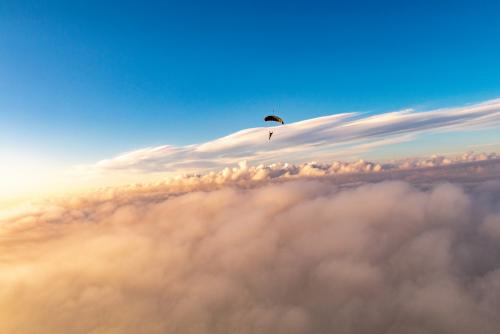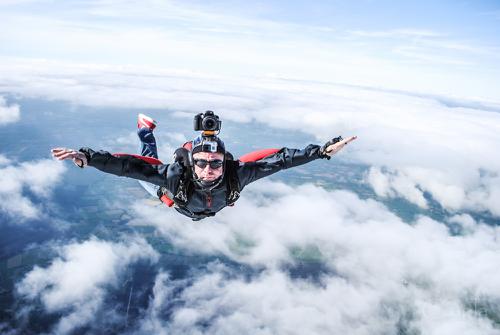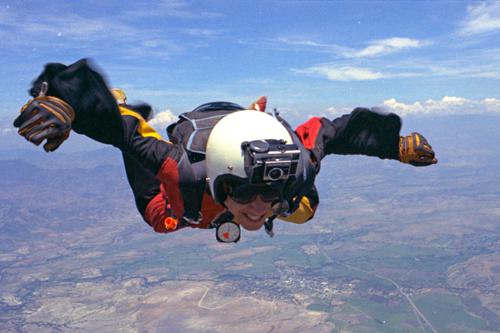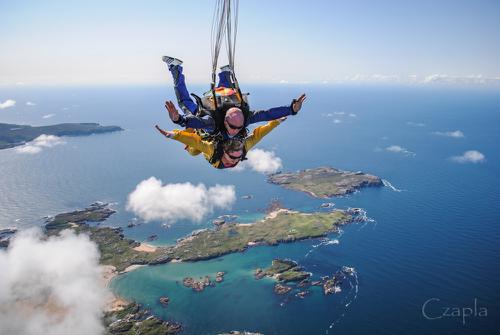First things first. I assume they're giving you some sort of compensation in the form of a free slot (since you're just starting out) or maybe slot plus a small amount of cash (maybe to cover pack jobs). Understand that since they hired you, they probably expect you to do certain things, only some of which you're actually going to be able to deliver because ... you're just starting out.
I can absolutely freekin' guarantee that your footage isn't going to look anything like the camera flyers at Arizona Airspeed can produce. You're just not going to do 1,000 jumps with your team this season, so nobody should expect the same results. Make certain at least the team captain understands this. If your team captain or the coach of the team expects otherwise, you may want to consider walking away right now. I'm not kidding. I saw a perfectly acceptable camera flyer get psychologically and verbally burned by his team last season because they just didn't have a freekin' clue as to how difficult "Airspeed-quality" camera flying is.
If, on the other hand, they understand where you're at in your camera-flying career and are willing to work with you, then it can be a beautiful learning experience for everyone.
Flying 4-way camera, you're not just flying the camera anymore. The team may decide you have other duties as well. Do they want you to handle the manifest duties? Do they want you to watch the clock so they can focus more on creeping? Are you going to be responsible for the spot? Will you have to dub tapes for everyone at the end of the day? This can be time-consuming. They're off in the bar having a cold one and you're in a debrief room makin' dubs for 40 minutes! Talk to them about it. Get that stuff understood so there are no surprises. Surprises cause arguments. Arguments are not conducive to good flying!
One camera flyer I know has been at it so long and has been burned so many times that he has what he calls his "List of Demands" and when he talks to a team he gives them a printed copy of it and says "That's the deal, take it or leave it." Now, since you're just starting out, you probably can't do this just yet, but keep it in the back of your mind. At least with him, there are no surprises. Just a thought.
The first day
So it's the first day of training and time to get on the airplane. Make absolutely freekin' sure that everyone knows the break-off plan. Typical might be that at 4,000 AGL the team turns and tracks while you pull in the center. (Maybe 4,500 for a newbie group.) Make certain they all understand the consequences of not tracking -- you'll eventually come down to meet them and you'll both die. I shoot my team's break-off and freeze-frame it when I dub the debrief tape just to make a point of showing which person is leaving last. I've never mentioned it in those terms, but I think it does get the point across when you see the same person not getting away as fast as the rest of the team.
Communicate to the team that's it's not only important that they turn and track, but it's also important that they do not pull high. Pulling high is where you are, not them. They shouldn't be pulling any higher than 3,000. This ensures they have separation from each other AND you.
What's really nice about 4-way is that certain things can be somewhat consistent and therefore I feel a bit more safe. You shouldn't have to worry about what the break-off altitude is for this jump, if the team break-off plan is always 4,000. Pretty simple, we're doing 4-way, break-off is 4,000 -- period, end of discussion. We can now focus on other things and not have to worry about break-off. Simple.
Same deal with most of the rest of the flow. Ten minutes to boarding the plane, check your gear, put it on and walk down to the mock-up. Five minutes to boarding the plane the team arrives at the mock-up and goes through the exit and does pin-checks. Board the plane in the same order, sit by the same person, check your camera at 6,000, do another pin-check at 9,000, handshakes at 10,000, put your helmet on by 11,500. CamEye II blue light on the red light, red light on the green light. OK, that's my routine, but you get the idea. Consistency will keep you on schedule, give you several opportunities to catch small errors and correct them.
Not all camera flyers' offices on Twin Otters are created equal! Handles come in at least three distinct flavors and steps in at least two. Placement of handles and steps varies from plane to plane even on the same dropzone and even if the A&P; mechanic was really trying to be consistent! Door frames are also inconsistent in how much they have little bits poking out that can whack into your left knee or attempt to grab your reserve handle on climbout. It may piss you off, but them's the facts. Look the planes over carefully and learn which ones to watch out for.
The exit
For a camera flyer, there are basically two parts to the skydive: Exit and everything else. Blowing the exit can make everything else irrelevant, so I'll start with that.
As I mentioned before, there are several version of handles and steps you'll have to deal with. Depending on the exact type of exit you're planning on doing, your hand and foot placement as well as your posture on the step will vary.
There are three basic exits.
Leading - leaving perhaps slightly before the 4-way team. This is the "classic" 4-way exit you'll see from Arizona Airspeed. There are a lot of timing issues involved with this exit and I'll go into some of them a bit later. When done well, it's a beautiful thing. When done poorly, it's a disaster! Try to learn this exit as quickly as you can, but I can guarantee you some spectacular disasters in the process. I do a lot of 4-way camera flying and even after three years of really trying to nail it, I still blow it from time to time.
Trailing - leaving perhaps just slightly after the team; it's also known as the peel. Almost bullet proof because you leave the airplane in your own clean air, but teams and coaches don't like it because it's difficult for them to see exactly how well they were presented on exit.
Semi-peel - also known as the 3 O'clock or 90. The team really has to launch away from the airplane for this to work and it has the same team/coaching issues as the trailing exit, but the camera flyer is a heck of a lot closer and it's very easy to see the grips so I think there are actually advantages to using this for competition, but like I said, teams and coaches might think differently. This is the exit you'll most likely see from The Golden Knights.
For each exit, it's fairly important to know exactly what to expect from the team in terms of timing and their presentation. You're a fifth member of that exit and you want to place your body in an exact location just the same as the rest of the team -- you're just not taking grips. I think it's important that you go to the mock-up with the team, find out what formation they're taking out the door and do a couple of practice exits with them every time you go up. For a leading exit in particular, find out where the tail and inside center are going to be and plan on not being in their burble right off the plane.
Depending on the team and their skill level, you could use any of the three basic exits. For coaching purposes, almost all teams will want you to give them a perfect leading exit. In reality, this may or may not be possible due to your experience level or theirs. It's definitely something to discuss with them. The team, the coach and you should understand that a leading exit is not always the best choice for competition purposes and may not always show what they wanted to see for coaching purposes either.
Leading exits
Get out on the camera step as best you can. Ideally, you'll have your left foot on the camera step and your left hand on the camera handle with your body hugging the airplane, right foot trailing and right hand maybe on top of the fuselage. At least, that's the way the boys over at Airspeed do it. Me? I can't do it that way and my guess is that depending on your body type, the handles, how much you can twist your neck and a bunch of other factors, you might need to do something slightly different too. Ultimately, your goal should be to be comfortable, stretched pretty far back with maybe just a little flex remaining in your left leg with which you can spring back off the camera step.
You may find it a good idea to have your camera sight centered on either the left wheel of the Twin Otter or maybe the butt of the tail flyer. This gives the team somewhere to go in the video.
If you can see the exit count, cool, but don't trust it. I usually watch for other subtle signs like a helmet popping under a head jam or maybe the tail flyer's butt leaving the plane. What is GREAT is if you can get the outside center to swing his left leg in time with the exit count -- of course, that's not going to work for all the exits, but it helps. Try to explain to the team that consistency on their part with the exit count means you'll be able to get them much better footage. Some teams do wacky things for a count -- I hate wacky. A nice rhythm of ready, set, go works wonders.
For the leading exit, I go on go. That is to say, right with the team. Me -- I'm a fat boy. If I leave too early, it's a pain in the ass to try to get up in a position where I can still see all the grips. You'll know you've left too early if you can see a lot of the bottom of the airplane and they're still in it! You'll know you've left too late in a leading exit when you whack into the team. I try to leave on go, pop my wings to get another slight bit of separation and then track up and over them as they fall down the hill. For me, what I want to see is the center of the formation falling below the horizon as quickly as possible after exit. As the team falls down the hill, drive up and over them. When I exit, I shift my focus from the before exit picture to place my ring-sight on an exact spot in the formation -- maybe the center grip on a Meeker for instance. Each formation is slightly different and will all call for a slightly different spot.
For the leading exits, look at the dive pool and think about how they might fly on exit. More importantly, think about how they might block your air on exit. Nice roundy thingies like Meekers aren't too much of a problem. Evil longy thingies like Monopods can be a huge problem depending on what the tail does. Some nice semi-roundy thingies like Satellites might look easy, but might have a tendency to "cut in" so that you can't see all the grips. It won't always be your fault, but you might always get blamed for it if people don't understand.
Trailing exits
In almost the exact opposition of the leading exit, don't lean back but try to stand up on the camera step and get your body high. Go ahead and put your focus on the center of the formation and don't worry too much about the count. Just keep the focus on the center of the formation and follow it down the hill. I try to think about placing my body in the 12 o'clock position just over the point flyer. Bingo, works like a charm. You don't really need to drive your body anywhere during this exit, the team will flatten out as they come down the hill and you should already be in pretty much good position. You will, however, be facing down jumprun as opposed to up jumprun for the leading exit.
Semi-peel exits
If you know the team will launch away from the plane, you can try a semi-peel exit. Almost the same as the trailing exit, but you don't really wait for the team to go by you. You leave just after the center has cleared the plane. Your body comes off at a 90 degree angle to jumprun and you may want to think about back sliding a bit under the plane.
Everything else
Once you've exited the airplane, there's pretty much nothing more you can do about the moment, so let it go. If you left too early on a leading exit, don't think about it -- do something about it! If you've left too late on a leading exit, you need to do something about it NOW! Keep working the issue until you've gotten things in hand. Keep focusing on where the sight should be, but keep working the problem. If you're going to whack into the team, keep trying to get big and maybe you'll be able to slide out of it. If you give up and put your hands in front of you to cushion the blow, you'll only speed up and hit them harder.
Your goal should be to get close enough and steep enough to the team so that all the grips are visible. If the team flies apart during a transition, you must get higher and try to keep them all in the frame. As they rejoin, come back down so they don't look like ants! A nice secondary goal would be to keep on heading. Pick a road in the background and keep the teams original jumprun heading relative to it. This let's the team and coach look for things like unintentional rotations of the formation. As you get used to flying with the team, try to get closer and steeper. As you get steeper, you'll find that it becomes a bit more difficult to stay on heading. Teams have a tendency to move quite a bit horizontally as they turn pieces and make transitions. Obviously, if you're right over the top, you'll have to side-slide, back-slide and do all sorts of chasing.
Breakoff and opening
OK, you've exited, shot freefall and it's about time to breakoff.
On breakoff (let's call it 4,000), I might give the wings a little pop and deploy as I continue to watch the team. As I said before, I usually watch to see who has left the formation last and will show that on the debrief tape just to subtly drive the point home.
As the d-bag comes out of the container, I begin to sit up and shift my ring-sight to the horizon in an attempt to have my head, neck and back in a straight line as the canopy opens. I feel that this gives the best protection against neck strains, but obviously, this might not work for you. It does work well for me. No matter what your body position, you want to get your hands on your risers as quickly as possible between the time you deploy and full inflation. An additional benefit of looking toward the horizon during inflation is that in this head level position, you can watch out for team members doing short tracks and high openings.
Individual team members probably have more than enough separation from each other, but if one dumps a little high and you maybe have a little bit longer snivel and they have a 180 opening, well, it can get interesting and you need to react pretty damn fast. Looking out toward the horizon lets you see what might be coming up to meet you, and you may even be able to shift your weight during inflation to avoid it.
After opening, look around to see who in your team is where. Give 'em a quick head count and see if there were any cutaways. If there was a cutaway, first look to see if you can spot the reserve. If the jumper looks OK under the reserve, then check to see if anyone is chasing the main and freebag. Especially watch for the freebag -- they can be a lot harder to find than the main. Make sure that at least one team member is following each piece down; main, reserve freebag and jumper. Fill in where required.
If everyone seems OK under canopy, then unclip your wings, release your thumb loops, stow your slider, turn off your camera, release your brakes and start flying back to the landing area. Since you're probably the high opener, you should have plenty of time and altitude to scan for traffic and fit in with the landing pattern. Usually, there's no need to rush and spiral down between canopies -- try to be predictable. With the ring-sight in front of one eye, you don't have the best vision so be a little more careful.
Once you've landed, if you can, go over and do high-fives with the team, but generally keep your comments to yourself. Generally speaking, you're not a judge and you're not their coach. They usually already know if they brain-locked or went low so additional negative comments from you aren't helpful. However, positive comments about really cool jumps are almost always welcome.
Wrapping up
As soon as you get back to the packing area, put your rig down, head over to the debrief room and dub the tape. You don't need to stop to talk with anyone at this point -- just dub the dang tape. Teams seem to vary on exactly what they want dubbed on their tapes, but usually I slate the first jump of the day with a date and just give them a few seconds before exit until the last guy breaks off. During competition, usually you'll slate EVERY jump. Some teams seem to like to see a slo-mo of their jump from exit to the second point, but some do not, so you might want to ask about it for team training purposes. You'd never do this for competition.
After you dub, pack and be ready to get on the next load before doing any socializing. The key point here is that the team should never have to wait for you -- not to pack, not to get to the plane, not EVER.
I have to admit that when I'm doing team training I usually don't pack -- I hire a packer. This cuts into my profit margin, but I find that I have a heck of a lot more energy at the end of a +20 jump weekend! I also have two rigs so that if the team wants or needs to do back-to-back loads it's really no issue. Having two rigs also means that if I have a cutaway, then I can continue to jump with minimal impact to the training.
At the end of the training day, typically the team members want dubs of the entire day. Ugh! Well, you can cut down on this particular chore by using one of the team members' tapes as the debrief tape during the day. I also cut this chore way down by having several VHS decks in my team room. I was able to pick up VHS decks pretty cheap ($75 each) and this also means that I never have to worry about having a back-up!
Photos: © Paul Quade







